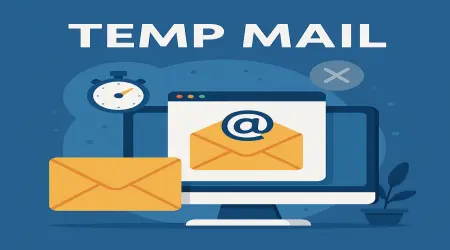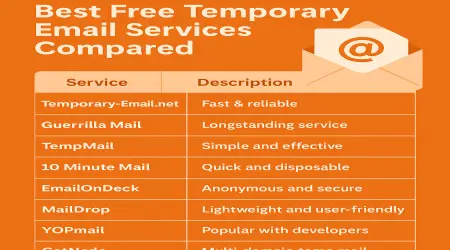

Temporary Email vs Fake Email – What’s the Difference?
Introduction to Disposable Email Addresses
In today’s digital world, email addresses are like online passports. From signing up for newsletters to creating social media accounts, you need an email for almost everything. But with spam, phishing, and unwanted advertisements constantly flooding inboxes, many users turn to alternative solutions—namely temporary emails and fake emails. While both may seem similar at first glance, they serve very different purposes.
This article dives deep into temporary email vs fake email, highlighting their definitions, use cases, risks, and benefits so you can decide which option fits your needs.
What is a Temporary Email?
Definition and Purpose
A temporary email (also known as a disposable email, temp mail, or throwaway email) is a short-lived email address that automatically expires after a certain time.
For example, services like 10 Minute Mail or Guerrilla Mail allow users to create an inbox valid for 10 minutes to a few hours.
How Temporary Emails Work
The system generates a random email address.
You can receive messages at this address without registration.
After the time limit, the email address and inbox disappear.
Common Use Cases for Temporary Emails
Signing up for free trials.
Accessing gated content without spam risk.
Protecting your real email from leaks.
Preventing identity theft during online testing.
What is a Fake Email?
Definition and Intent
A fake email refers to an invalid, fabricated, or misleading email address. Unlike temporary emails, these are not hosted by legitimate disposable email providers. Instead, they are simply made-up email addresses that don’t exist.
Types of Fake Emails
Completely Random: e.g.,
[email protected]Typo-based: e.g.,
gmial.cominstead ofgmail.comMalicious Fake Emails: Used for fraud or scams
Why People Use Fake Emails
To bypass mandatory email fields during sign-ups.
To avoid spam without using a real account.
To mislead businesses or trick verification systems.
Key Differences Between Temporary Email and Fake Email
Legitimacy and Functionality
Temporary Email: Real, functional inbox for a short period.
Fake Email: Non-functional, cannot receive emails.
Security and Privacy Aspects
Temporary email provides privacy protection.
Fake email offers no security—just avoidance.
Usage Scenarios
Temporary email works when you need to receive confirmation codes or links.
Fake emails fail in scenarios where actual inbox verification is required.
Ethical and Legal Considerations
Using a temporary email is legal and practical.
Using a fake email can sometimes be unethical and may violate platform terms of service.
Pros and Cons of Temporary Emails
Advantages of Using Temporary Emails
Protects against spam.
Easy to create and dispose of.
No personal data required.
Limitations of Temporary Emails
Inaccessible after expiry.
Not suitable for long-term accounts.
Some websites block known temp mail domains.
Pros and Cons of Fake Emails
Benefits of Fake Emails (from a user’s perspective)
Quick and effortless.
Helps bypass mandatory forms.
Risks and Downsides of Fake Emails
Cannot receive confirmation emails.
Increases risk of account loss.
Can trigger fraud detection systems.
When Should You Use a Temporary Email?
Signing up for newsletters.
Accessing limited-time promotions.
Testing apps without exposing personal email.
When Should You Avoid Fake Emails?
When you need to access password resets.
When verifying accounts.
In professional or business contexts.
The Role of Disposable Email in Cybersecurity
Temporary emails can reduce phishing risks and protect privacy. However, cybercriminals sometimes misuse them for fraud, making businesses cautious.
Popular Temporary Email Services You Can Try
Temp Mail
10 Minute Mail
Guerrilla Mail
Mailinator
👉 Learn more about Guerrilla Mail here.
How Businesses Can Detect and Handle Fake/Temporary Emails
Use email verification APIs.
Block disposable domains if needed.
Encourage real users with incentives.
FAQs on Temporary vs Fake Emails
1. Is temporary email safe to use?
Yes, but only for short-term needs. Don’t use it for banking or personal accounts.
2. Can fake emails receive messages?
No. Fake emails don’t exist on real servers.
3. Why do websites block temporary emails?
To reduce spam sign-ups and ensure genuine users.
4. Are temporary emails anonymous?
Yes, they don’t require personal details.
5. Can I create a fake email for fun?
Yes, but it won’t work for verification.
6. Which is better: temporary email or fake email?
Temporary email is always better since it’s functional and safer.
Conclusion: Making the Right Choice
While both temporary emails and fake emails provide alternatives to your real inbox, they serve different purposes. Temporary emails are functional, secure, and reliable for short-term needs. Fake emails, on the other hand, are non-functional, risky, and often impractical.
If you want to protect your privacy without losing access to verification codes, always choose temporary email services over fake ones.

